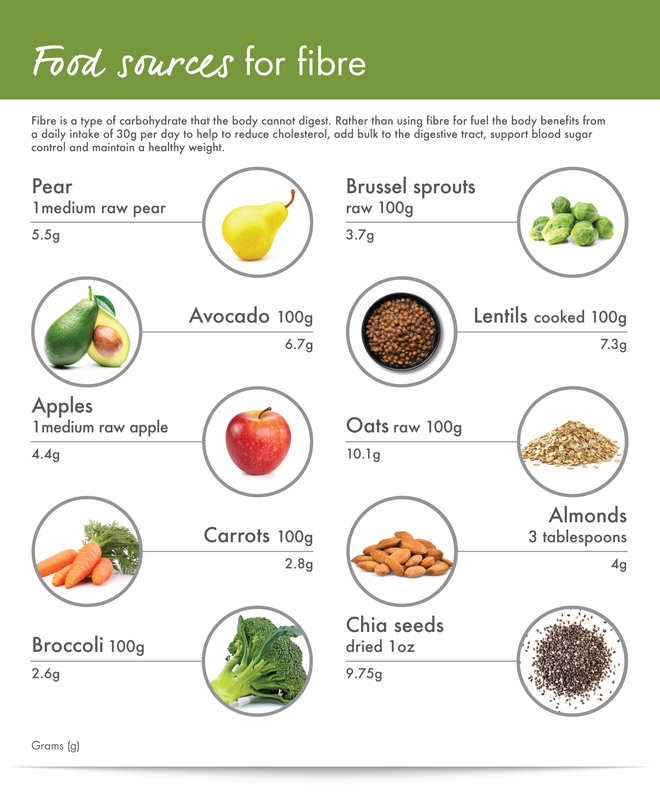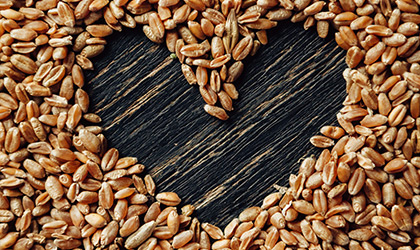
As humans, we evolved to eat fibre – and lots of it. Our hunter-gatherer ancestors survived off a diet of fibre-rich fruits, shoots, roots, nuts, and seeds. Research on the Hadza people – one of the few remaining hunter-gatherer groups living in Tanzania, making them a helpful model for gauging what early humans ate – found tribe members consume between 100 and 150 grams of fibre daily (1).
Unlike the Hadza, official guidelines only call for our fibre intake to hit 30 grams daily (2). And yet, most Brits consume around 17-20 grams, leading to what experts have labelled the ‘fibre gap’ – a public health problem of the highest emergency (3).
There’s much more to fibre than meets the eye – and it stretches far beyond just ‘helping us poop’. It has a truly extraordinary impact on the cardiovascular system, weight maintenance, and gut health.
The take-home message is this: eating more fibre is the easiest way to transform our wellbeing.
What is fibre?
Fibre is a simple yet often misunderstood nutrient. Fibre is a carbohydrate found abundantly in plant foods. But unlike most carbohydrates – which are broken down into sugar (glucose) – fibre can't be digested by the body. Instead, it passes relatively unchanged through the stomach until it reaches the large intestines, where it’s broken down (fermented) by your gut bacteria.
What are the different types of fibre?
Historically, we've divided fibre into two categories: soluble and insoluble. Soluble fibre dissolves in water and becomes a gel-like substance in the digestive tract. This action slows digestion, helping you feel fuller for longer and minimising blood sugar spikes. Soluble fibre also makes your stool easier to pass. You can find it in oats (beta glucans), bananas (inulin), beans, nuts, seeds, and chicory root.
Insoluble fibre, on the other hand, doesn't dissolve in water. It helps move food and waste through your body and supports regular bowel movements. Wholegrains, like brown rice, leafy greens, vegetables, nuts and seeds are great examples of insoluble fibre.
However, some experts believe the 'soluble' vs. 'insoluble' notion is somewhat inaccurate (4). In truth, there are hundreds of different types of fibre. And most fibre-filled food contains a mix. As long as you eat a diverse, whole food diet – with a range of plant foods – you'll cover all bases.
Why do we need fibre?
Fibre used to have a bit of a boring reputation. For years, it was associated with bowel movements and preventing constipation. But there’s a renaissance happening in science: the more we learn about fibre, the more exciting it becomes. And though it deserves credit for supporting the digestive system, its importance extends beyond healthy bathroom activities.
Fibre-rich food is a workhorse for your health. Based on all the scientific data, eating more of it can literally extend your life (5).
Fibre supports:
-
Gut health
-
Regular bowel movements
-
Heart health
-
Cholesterol regulation
-
Blood sugar control
-
Weight loss
Which foods are high in fibre?
Fibre isn’t hard to find. The natural world is teeming with it. Upping your intake of plants is the easiest way to increase fibre. All plant foods contain fibre: fruit, vegetables, wholegrains, legumes, nuts, and seeds. There’s one exception to this rule: mushrooms – technically, they’re not plants; they’re fungi. But they can still be a great source of dietary fibre. We like to call them ‘honorary plants’.
As mentioned, there are many different types of fibre to support health. Aiming for a diverse range of plant foods each week will ensure you hit every nutritional note. Don’t just stick to fruit or wholegrains to meet your daily allowance. Try to mix things up.

How to increase your fibre intake?
Aside from upping plant foods and diversifying your weekly shop, here are some easy ways to sneak more fibre into your diet.
-
Switch to wholegrains. Replace white bread, rice, and pasta with their wholegrain counterparts, including millet, brown rice, and quinoa.
-
Maximise the fibre content of meals. Add chia seeds to smoothies, chopped vegetables to soups, and berries to yoghurt.
-
Add fruit and veggies. Throw watercress in soup or raspberries in porridge.
-
Eat the skin. Most fibre in fruits and veggies is in their skin. Just rinse first.
-
Keep a jar of mixed seeds and nuts in your kitchen pantry. Sprinkle them on salads, stews, and smoothies.
-
Increase plant-based proteins. Lentils, beans, and peas are packed with fibre.
-
Snack on raw vegetables and nuts instead of crisps and sweets.
-
Always choose whole fruits over fruit juices.
How does fibre support gut health?
Dietary fibre serves as food for the trillions of microbes – collectively known as the gut microbiome – living in the gut. Gut microbes break down the fibre in a process of fermentation, which produces different metabolites called short-chain fatty acids (SCFAs) (6). These incredible compounds have diverse functions – and are responsible for many of the health benefits associated with fibre.
SCFAs support:
-
Gut health
-
Blood sugar response
-
Weight control
-
Inflammation response
A 2-week study found participants who followed a high-fibre, whole-food, plant-predominant diet had significantly increased gut microbial diversity (7).
How does fibre support blood sugar regulation?
Everyone needs blood sugar; it powers muscles, tissues and organs. Problems start to arise, however, when we experience disproportionate spikes in our blood sugar levels. The variabilities caused by glucose surges can lead to challenging health conditions. Fortunately, eating more fibre is one of the best ways to help restore some balance to blood sugar levels.
Research suggests anchoring carbs with fibre can significantly lower the increase in blood glucose (9). Eating carbs with fibre means the glucose from the starchy food won’t hit your bloodstream as quickly, causing a smaller spike. In other words, instead of just reaching for plain bread, add fibre-rich tomatoes, hummus, and rocket.
How does fibre support weight management?
Increasing your fibre intake is also one of the easiest and simplest dietary changes you can make to support weight loss. Scientists believe there’s a link between higher fibre intake and lower obesity rates (8). Fibre keeps you fuller for longer than other carbs. Soluble fibre, in particular, turns to a gel-like consistency in your digestive system, slowing digestion, increasing feelings of satiety, and facilitating weight loss (10).
How does fibre support heart health?
In the 1970s, scientists first discovered fibre was important for heart health. And since then, the evidence keeps rolling in. Studies report people with a high fibre intake tend to have lower blood pressure, cholesterol, and body weight, all of which are great for heart health (11).
Most notably, fibre reduces fat and cholesterol absorption. Some soluble fibres, including those found in oats, barley, and pulses, produce a gel-like substance in the gut, which captures cholesterol and prevents it from being reabsorbed into the bloodstream (12). Then, cholesterol is excreted from the body via the stool.
What happens if you introduce fibre too quickly?
An increase in fibre can only be a good thing. However, introducing it too quickly – especially if you don’t eat much fibre from the get-go – can lead to uncomfortable digestive symptoms like cramping, gas, and bloating. So, try to increase your fibre consumption gradually. Consider adding a few grams of fibre every week.
Don’t forget to drink enough water, too. Fibre needs water to be properly digested. With enough water, fibre turns into a gel-like substance and slows digestion. However, without enough, stools become too dry and bulky to pass comfortably. The result? Digestive discomfort, constipation, and gas.
Find out more
If you found this article on fibre useful, you can find similar guidance on our health blog. Alternatively, please get in touch with our team of expert Nutrition Advisors, who are on hand to provide free, confidential advice.
References:
-
Smits, S.A. et al. (2017) Seasonal cycling in the gut microbiome of the Hadza hunter-gatherers of Tanzania. Science 357(6353):802–806.
-
www.nutrition.org.uk. (n.d.) Fibre - British Nutrition Foundation. [online] Available at: https://www.nutrition.org.uk/healthy-sustainable-diets/starchy-foods-sugar-and-fibre/fibre/?level=Health%20professional
-
Thompson HJ, Brick MA. (2016) Perspective: Closing the Dietary Fiber Gap: An Ancient Solution for a 21st Century Problem. Adv Nutr 7(4):623-6.
-
Dr. Megan Rossi (2020). Different types of fibre: forget ‘insoluble’ vs 'soluble! [online] The Gut Health Doctor. Available at: https://www.theguthealthdoctor.com/different-types-of-fibre
-
Reynolds, A. et al. (2019) Carbohydrate quality and human health: A series of systematic reviews and meta-analyses, The Lancet 393(10170):434–445.
-
Lewis G, Wang B, Shafiei Jahani P, et al. (2019) Dietary Fiber-Induced Microbial Short Chain Fatty Acids Suppress ILC2-Dependent Airway Inflammation. Front Immunol 10:2051.
-
Oliver, A., Chase, A.B., Weihe, C., et al. (2021). High-Fiber, Whole-Food Dietary Intervention Alters the Human Gut Microbiome but Not Fecal Short-Chain Fatty Acids. mSystems 6(2).
-
Miketinas DC, Bray GA, Beyl RA, et al. (2019) Fiber Intake Predicts Weight Loss and Dietary Adherence in Adults Consuming Calorie-Restricted Diets: The POUNDS Lost (Preventing Overweight Using Novel Dietary Strategies) Study. J Nutr 149(10):1742-1748.
-
joinzoe.com. (n.d.) Fiber: Why Is It So Important? [online] Available at: https://joinzoe.com/learn/what-does-fiber-do-for-the-body.
-
Slavin J. (2013) Fiber and prebiotics: mechanisms and health benefits. Nutrients 5(4):1417-35.
-
Threapleton, D.E., Greenwood, D.C., Evans, C.E.L., et al. (2013). Dietary fibre intake and risk of cardiovascular disease: systematic review and meta-analysis. BMJ 347(dec19 2):f6879–f6879.
-
Soliman GA. (2019) Dietary Fiber, Atherosclerosis, and Cardiovascular Disease. Nutrients 11(5):1155.
You Might Also Like

Olivia
Olivia Salter has always been an avid health nut. After graduating from the University of Bristol, she began working for a nutritional consultancy where she discovered her passion for all things wellness-related. There, she executed much of the company’s content marketing strategy and found her niche in health writing, publishing articles in Women’s Health, Mind Body Green, Thrive and Psychologies.
View More



